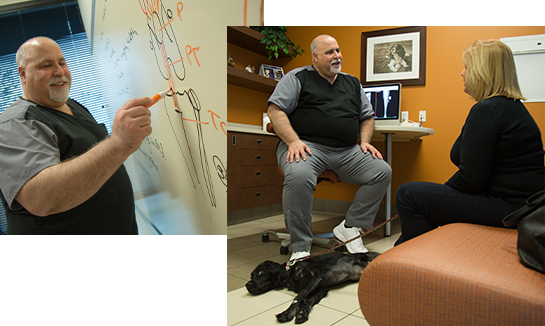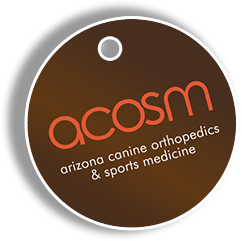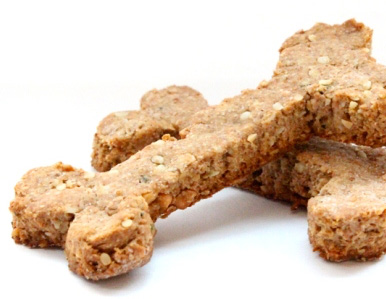Benefits of Pre-Operative Planning for TPLO
Collins et al. “Benefits of Pre- and Intraoperative Planning For Tibial Plateau Leveling Osteotomy.” Veterinary Surgery 43 (2014): 142-149. DOI:10.1111/j.1532-950X.2013.12093.x
Key Point: Precise preoperative planning and intraoperative execution reduces the risk of major complications following tibial plateau leveling osteotomy.
Cranial cruciate ligament disease (CCLD) is a common cause for hindlimb lameness in dogs. CCLD is a degenerative condition in which progressive weakening of the ligament leads to fiber degeneration and eventual rupture of the ligament over time. Rupture of the ligament results in knee joint instability and can be associated with concurrent injury to the medial meniscus and cartilage damage resulting in pain secondary to joint inflammation and chronic osteoarthritis.
Surgical treatment of CCLD is generally associated with superior functional outcomes when compared with conservative management. While many options for surgery exist, tibial plateau leveling osteotomy (TPLO) is widely considered the “gold-standard” in most dogs, regardless of size, due to the relatively low complication rate, rapid return to function and good long-term outcome.
In cases of complete rupture of the CCL, TPLO restores knee joint stability by altering the shape of the tibial plateau, eliminating the tendency for the femur to displace backwards during weight bearing. When performed for treatment of partial/stable tears, the procedure has been shown to slow degeneration by reducing strain on the remaining ligament. The TPLO procedure involves creating a radial cut in the tibia, around which the tibial plateau is rotated and fixed in place with a bone plate, creating a more level weight-bearing surface.
When performing a TPLO, determining where on the bone to position the saw blade is a critical part of the procedure. This can be “free-handed” at the time of surgery or can be determined before surgery using radiographs. An accurately positioned osteotomy will be positioned over the center of the knee joint and variability in the location and orientation may lead to under or over-rotation, angular deformity or risk of complications such as tibial crest fracture and late meniscal injury.
In the study by Collins et al., the medical records of over 400 dogs that had TPLO surgery were evaluated. Dogs were divided into 2 groups - those that had pre- and intraoperative planning and those that had the location of the osteotomy determined visually at the time of surgery.
The authors determined that those dogs that had pre- and intraoperative planning had more accurately positioned bone cuts than those with free-hand positioned cuts. Additionally, there were no dogs in the planning group that suffered tibial crest fracture, compared with 20 (nearly 7% of dogs) in the free-hand group. The results of this study suggest that careful preoperative planning results in a more reproducible and centered osteotomy and reduces the risk of tibial crest fracture in dogs undergoing TPLO surgery.
Previous landmark work by Kowaleski et al., determined the effects of a non-centered osteotomy when performing TPLO. When free-handing the bone cut, there is a tendency to move the cut down and forwards to ensure adequate room for the bone plate - a position that results in a deviation from the desired plateau leveling (resulting in a greater postoperative tibial plateau angle than what was planned for). Preoperative planning demonstrates that a centered cut allows more than enough room for the implants, while ensuring that the planned correction is accurate.
At ACOSM, preoperative planning is considered an essential aspect of performing tibial plateau leveling osteotomy (in addition to most other procedures). Prior to surgery, radiographs of the lower hind limb, including the knee joint are obtained. These radiographs are calibrated and position in such a way that our surgeons can use them to precisely plan your pet’s surgery. While the method of planning has evolved from that used in the Collins et al. study, the general process is the same - reproducible landmarks are identified and measured on the preoperative X-rays and these measurements are transferred to the bone in surgery. Preoperative plans are made using computer software and the images are displayed in the operating room during the procedure to use as a reference. By doing so, we can ensure the best possible outcome for your dog and reduce the risk of postoperative complications.
The image below is an example of using two-dimensional, digital, orthopedic planning software (OrthoView Vet) to identify the ideal position of the TPLO saw cut with reference to the dog's tibial anatomy and may be used during surgery.


Get Informed
Schedule a Consultation
Make no mistake, all surgical procedures are serious. Get the information you need and know your options. Then make an informed decision. Like any service, not all veterinary services are equal. Call to schedule or ask questions.
Call our clinic at 480.998.5999
or Email us.
FAQ
What Makes ACOSM Stand Out?
We pride ourselves on doing things differently. We insist on providing premier service to our patients and their caregivers. There's a saying, "Price is what you pay; value is what you get." At ACOSM, delivering on value is our mission.
We're proud of our experience, skill, and outcomes; it puts us in a category of one, which means you'll experience things with us not promised by any other veterinarian in AZ.
Dog Blog
Distal Femoral Osteotomy for Comprehensive Treatment of Medial Patella Luxation
Three-Dimensional Printed Patient Specific Guides for Acute Correction of Deformities
Comparison of Arthroscopy and Arthrotomy for Diagnosis of Medial Meniscal Pathology
Second Look Arthroscopic Findings After Tibial Plateau Leveling Osteotomy
Resources
New Patient Registration Forms
- New Patient Packet

- New Patient Packet - Online
 New online form!
New online form! - Patient Referral Form

- Patient Referral Form - Online


